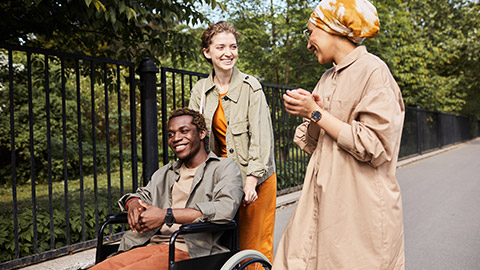In order to promote community participation and inclusion, it is essential to implement strategies tailored to each individual's needs and goals. By developing an individualised plan, we can create a roadmap for fostering meaningful engagement and integration within the community. This plan takes into account the unique interests, abilities, and aspirations of the person, guiding us in implementing targeted strategies that support their active involvement and ensure they feel valued and included. Through thoughtful implementation of these strategies, we can empower individuals to thrive and contribute to their communities, fostering a sense of belonging and enhancing their overall quality of life.
Understanding the person is key. Take the time to get to know individuals with disabilities, their interests, strengths, and goals. This understanding will help you create strategies tailored to their specific needs and desires. By recognising their unique qualities and aspirations, you can develop approaches that truly support their participation and inclusion in the community. Collaborative planning is essential. Work closely with the individuals and their support network to develop a plan that centers around their goals and aspirations. Involve them in decision-making and consider their interests, hobbies, and desired community activities.
By including their input, you ensure that the strategies implemented align with their preferences and promote their engagement in meaningful community interactions. Explore community resources and opportunities. Seek out inclusive and accessible resources and activities within the community that cater to individuals with disabilities. Research local organisations, recreational programs, social groups, educational courses, and government initiatives that support community participation. By connecting individuals with these resources, you create opportunities for them to engage, learn, and interact within their community. Provide support and accommodations. Offer ongoing support and necessary accommodations to facilitate community participation.
This can involve assisting individuals in developing skills such as communication, navigating public transportation, or using assistive technology. Additionally, connect them with support networks, advocate for inclusive practices, and ensure access to accommodations such as accessibility modifications and communication devices. By providing the necessary support, you empower individuals with disabilities to actively participate and contribute to their communities. By understanding the person, engaging in collaborative planning, exploring community resources, and providing support and accommodations, you can foster an inclusive environment where individuals with disabilities can thrive and actively participate in their communities.
Read
What is social and community participation?
Watch
How to support a person with lived experience in the workplace | Peer Work Hub

When you are working with an individual to identify and access community options, begin by actively communicating with the person and listening to their needs, preferences, and goals. Create a supportive environment where they feel comfortable expressing themselves. Conduct a person-centered assessment to understand their abilities, interests, and support requirements. This assessment should consider their physical, cognitive, social, and emotional needs, providing a foundation for identifying suitable community options.
Communication is a key element when working with people with disabilities to identify their needs and preferences.
Communication is a crucial element when working with people with disabilities to identify their needs and preferences. It enables support workers to actively listen and understand the unique challenges and aspirations of the individuals they assist. By fostering trust and rapport through effective communication, support workers can empower the person to express their choices, opinions, and goals, leading to a person-centered approach in creating and implementing their support plan. Regular communication also allows for ongoing adjustments to the support provided, ensuring it remains relevant, flexible, and responsive to the person's changing needs and preferences. It helps in avoiding assumptions and stereotypes, recognising the individual's strengths and abilities, and promoting meaningful relationships based on mutual respect and understanding.
Read
Communicate and consult with people with a disability
Collaboration
Work together with the person to set meaningful goals related to community participation. Involve them in the decision-making process, ensuring their goals reflect their desires and preferences. Collaboratively define objectives that align with their interests, aspirations, and personal development. This collaborative approach empowers the person and fosters a sense of ownership over their choices and outcomes. Researching Community Resources: Research available community resources that cater to the person's needs and preferences.
Look into local community support groups, recreational programs, educational courses, volunteer opportunities, and cultural events. Seek inclusive and accessible options that align with the person's interests. By identifying suitable community resources, you can offer them a range of options to consider. Providing Support and Facilitating Connections is critical. You can do this by offering information and support by presenting the person with details about the identified community options. Address their questions and concerns, guiding them in making informed decisions. Assess the accessibility of the chosen options and advocate for necessary accommodations or modifications. Additionally, help facilitate connections by introducing them to relevant contacts and accompanying them during initial visits to community organisations.
By providing ongoing support and evaluation, you can ensure their needs and preferences are being met effectively. Remember, throughout the process, maintaining a person-centered and collaborative approach is essential. By actively involving the person, researching suitable community resources, providing support, and facilitating connections, you can assist them in identifying and accessing community options that align with their needs, preferences, and goals.
Activity
Look in your local area for community or council organisations that actively and support people with disability and consider these questions:
- Are there many options in your local community?
- Are the locations accessible to public transport?
- Are the organisations culturally and linguistically diverse?
- Are there a variety of options in terms of programs and activities in each organisation?

Having common interests fosters connections with others, promoting a sense of bonding. When individuals share hobbies like watching movies, reading, or exercising, it creates a platform for engaging in meaningful conversations and finding mutual ground. This shared affinity plays a vital role in breaking down barriers, especially for those who lack self-assurance. Furthermore, it significantly contributes to building robust relationships and fostering positive effects on both physical and mental health. Therefore, pairing participants and support workers based on shared interests proves to be a successful approach for various reasons.
Here are some of the reasons why this combination is beneficial for all involved.
When individuals are engaged in activities they enjoy and connect with like-minded people or their support worker, they often feel more empowered and valued. This positive influence on their self-perception and interpersonal skills can lead to improved communication and a greater sense of fulfillment in their daily lives. Ultimately, supporting the person in these endeavors not only enhances their quality of life but also promotes their overall happiness and mental well-being.
A support worker can effectively assist and motivate a participant in advancing their passions to the next level. This can be accomplished through various means. For instance, support workers can aid participants in pursuing further studies, connecting with like-minded individuals through community organizations, or establishing contacts with others who share the same interests.
Moreover, support workers may impart their own knowledge and expertise in the relevant areas. For example, if there's a mutual love for cooking, this could lead to the creation of innovative menus; a shared passion for gardening could result in a flourishing garden, and newly acquired technology skills could bring remarkable transformations. However, the benefits don't just end there. Research indicates that dedicating time to enjoyable activities can have a positive impact on mental health and overall well-being. Engaging in such activities can reduce the likelihood of experiencing low moods, stress, and depression.
Understanding a participant's preferences allows support workers to explore potential areas of interest, introducing new experiences and opportunities. This can involve discovering local activities, such as joining a soccer team or taking a cookery course, which participants might not have access to on their own. Engaging in novel experiences broadens horizons, reignites enthusiasm for life, and fosters a comprehensive care approach that addresses the participant's diverse needs.
Shared interests create stronger social bonds between participants and support workers, leading to a deeper connection and a sense of purpose in engaging in activities together. This solid connection becomes a foundation for participants to socialize and build relationships within the community, benefiting their mental and emotional well-being. Robust relationships can even contribute to improved physical health, including a strengthened immune system and enhanced disease recovery. Having a support worker to cheer them on and participate in shared activities empowers participants to achieve their goals and experience a sense of accomplishment. With the right support and motivation, participants can accomplish things they once considered beyond their reach, leading to a more fulfilling and enriched everyday life.
Read
Star Community Care: Benefits of Social and Community Participation
Mable: Five ways to facilitate your client's social inclusion and communication skills
Diversity Community Care: Innovative Community Participation
Foundation for people with learning disabilities: Community connecting
Watch
This webinar by People with Disability Australia (PWDA and Commons Library) was conducted in May 2023 and discusses how to be more inclusive of people with disability in campaigns.

Supporting individuals with disabilities to access opportunities for participation in work involves several key steps. First, it is crucial to understand the person's unique abilities, skills, and interests. Engage in open and respectful communication to identify their career goals and aspirations. Take the time to learn about their strengths and areas where they may require additional support.
Once their skills and interests are identified, provide guidance and resources for career exploration. Help them research various industries, job roles, and potential employers. Provide information on vocational training programs, educational resources, and job placement services tailored to individuals with disabilities. Support the person in developing necessary skills and qualifications for their chosen career path. This could involve providing access to training programs, or on-the-job learning opportunities.
Collaborate with vocational services to assist with skill-building and job readiness. Assist the person in creating a compelling resume and cover letter that highlights their abilities and experiences. Offer support in navigating the job application process, including online job portals, networking events, and job fairs. Help them present their strengths effectively to potential employers and address any concerns or challenges they may encounter during the job search. Advocate for workplace accommodations and accessibility to ensure a supportive and inclusive work environment. Use adequate assistive technologies if required, e.g iPad, mobile applications, speech recognition software or screen reading software.
Collaborate with employers to identify reasonable adjustments that address the person's specific needs, such as modifications to the physical workspace or the provision of assistive technologies. Provide ongoing support and guidance to the person in understanding their rights and advocating for their needs in the workplace. Networking can play a vital role in accessing work opportunities. Support the person in building professional networks by connecting them with mentors, disability employment services, and industry professionals. Encourage their participation in networking events, seminars, and professional development workshops to enhance their career prospects.
Regular check-ins and ongoing support are essential once the person has secured employment. Ensure they have the necessary support mechanisms in place, such as peer support groups, disability-specific resources, or workplace mentors. Evaluate their job satisfaction, progress, and opportunities for career advancement, making adjustments to their support as needed.
Always use person centred and strength based approaches to understand the person's abilities, providing guidance in career exploration, supporting skill development, assisting in job applications, advocating for workplace accommodations, facilitating networking, and offering ongoing support, individuals with disabilities can access meaningful work opportunities and participate fully in the workforce.
Read
NDIS: Social inclusion and community access research
Mable: Five ways to facilitate your clients social inclusion and communication skills
Watch
How to support a person with lived experience in the workplace | Peer Work Hub
Watch
People with disability facing huge barriers to workforce | The Drum

Assistive technology refers to any device, equipment, software, or system that helps individuals with disabilities perform tasks, increase independence, and improve their overall quality of life. These technologies can assist people with a range of disabilities, including physical, sensory, cognitive, or developmental impairments. Assistive technology can take various forms, including:
Mobility aids
Examples include wheelchairs, walkers, crutches, and prosthetic limbs that help individuals with mobility limitations move and navigate their surroundings. Communication aids
These devices assist individuals with speech or communication difficulties in expressing themselves. They can include speech-generating devices, augmentative and alternative communication (AAC) tools, or specialised apps.
Vision and hearing aids
Devices such as hearing aids, cochlear implants, screen readers, and magnifiers support individuals with hearing or visual impairments to enhance their auditory or visual experiences.
Adaptive tools
These tools are designed to enable individuals with dexterity or fine motor skill limitations to perform tasks independently. Examples include adapted keyboards, ergonomic utensils, or modified grip aids.
Environmental control systems
These systems allow individuals with limited mobility to control their environment, such as adjusting lighting, temperature, or operating household appliances through voice commands or remote controls.
Cognitive and learning aids
These technologies assist individuals with cognitive impairments or learning disabilities in areas such as memory, organization, or information processing. Examples include electronic organisers, task managers, or software with text-to-speech features.
Assistive software and apps
These encompass a wide range of computer programs, mobile apps, and assistive software tools that support individuals in various aspects of daily life, such as education, communication, productivity, or accessibility.
Assistive technology is designed to bridge the gap between an individual's abilities and the tasks they want to perform, promoting independence, inclusion, and equal opportunities for people with disabilities. The specific assistive technologies used depend on an individual's unique needs and can be tailored to their specific disability or impairment.
Supporting a person with a disability in using assistive technologies involves the following:
- Assessing Needs and Abilities: Start by understanding the person's specific disability and functional limitations.
- Providing Education and Training by offering comprehensive education and training on the assistive technologies that will support the person's independence and participation.
- Collaborating in Device Selection ensuring you involve the person in the decision-making process when selecting assistive technologies.
- Facilitating Access and Support and assist the person in acquiring the necessary assistive technologies and provide ongoing support in terms of device setup, troubleshooting, and software updates.
- Promoting Integration by encouraging and empowering the person to integrate assistive technologies into their daily routines and activities. Regular Monitoring and Evaluation: Conduct regular check-ins to assess the person's satisfaction, comfort, and effectiveness of the assistive technologies.
These strategies can provide ongoing support, training, and collaboration, individuals with disabilities can effectively use assistive technologies to enhance a person's independence and overall well-being.
Read
The following websites provide further information and resources about assistive technologies:
Ariia: Types of Assistive Technology
National Aged Care Alliance: Assistive Technology for Older Australians
Assistive Technology Essentials: An introduction to low risk assistive technology for Commonwealth Home Support Programme Service Providers
Watch
Watch
Assistive Technology Devices In Action For People With Disabilities.
This video looks at low-tech assistive technology.

As a disability support worker, seeking feedback from various individuals involved in the person's life is essential to ensure that the support provided continues to meet their current and changing needs and preferences.
The following information provide suggestions on how this could be done:
Regular check-ins and communication: Establish open lines of communication with the person with a disability, their family, and any other identified individuals. Schedule regular check-ins to discuss their experiences, progress, and any changes in their needs or preferences.
Use active listening: During these conversations, practice active listening to understand their feedback fully. Allow them to express their thoughts, concerns, and suggestions without interruption, ensuring they feel heard and valued.
Surveys and questionnaires: Consider using surveys or questionnaires to gather feedback from the person, family, carers, and other relevant individuals. Structured feedback forms can provide valuable insights into specific aspects of the support that may need improvement or adjustment.
Seek input from colleagues and supervisor: Collaborate with your colleagues and supervisor to gain their perspectives and expertise. They may have observations or insights that can contribute to improving the support provided to the person.
Focus groups or family meetings: Organise focus groups or family meetings to gather collective feedback and engage in open discussions. These sessions can be helpful in identifying patterns or themes that may not surface in individual conversations.
Adapt support plans: Use the feedback received to adapt the person's support plan. Be responsive to their changing needs and preferences, and ensure that the plan reflects their goals and aspirations accurately.
Continuous improvement: Embrace a culture of continuous improvement, where feedback is valued and acted upon. Demonstrate a willingness to learn and make necessary changes to enhance the person's support experience.
Regular reviews: Conduct regular reviews of the support plan in collaboration with the person, family, and other stakeholders. These reviews provide an opportunity to discuss progress, make adjustments, and set new goals.
Provide feedback channels: Establish accessible and confidential feedback channels to encourage individuals to share their thoughts openly. This can include in-person meetings, phone calls, email, or suggestion boxes.
Respond promptly: When feedback is received, respond promptly to acknowledge it and discuss any potential actions or changes. Show that the feedback is taken seriously and valued in the support process.
By actively seeking feedback from all involved parties, you create a person-centered approach that ensures the support provided remains tailored to the individual's evolving needs, preferences, and aspirations. This collaborative approach enhances the person's experience and contributes to their overall well-being and growth.
Read
Disability Support Guide: Hearing your customer
Watch
Why is feedback important?

It is important to ensure strategies for community participation and social inclusion are regularly reviewed with the person and supervisor to facilitate positive outcomes.
Regularly reviewing strategies for community participation and social inclusion is crucial for ensuring positive outcomes and a focus on the individual's needs. To do this, support workers and supervisors should schedule regular meetings with the person they are assisting. During these meetings, they reflect on progress and achievements, celebrating successes along the way.
In these review meetings, they evaluate how well the strategies are working to promote community participation and social inclusion. They ask for feedback from the person, their supervisor, and other involved parties to get a clear picture of what's working and what needs improvement. If there are any challenges, they openly discuss them and find ways to make things better.
Based on the evaluation and feedback, they set new goals and objectives that align with the person's wishes and current needs. It's essential to involve the person in this decision-making process, so they feel empowered and in control of their own journey. The support plan is then adjusted accordingly to ensure the person receives the best possible assistance in achieving their goals.
By maintaining open communication and continuous learning, support workers and supervisors can continuously improve their approach to help the person in the best way possible. This collaborative and proactive approach ensures that the support provided is always relevant, effective, and responsive to the person's evolving needs and aspirations.
Read
This fact sheet (Consulting with people with disability during a practice review) from the NDIS provides information about working with people with disability during a practice review

Monitoring the level of a person's engagement in the community and social networks, in consultation with both the person and the supervisor, involves a structured and collaborative approach. Firstly, clear indicators are established to assess the person's engagement, such as attendance at community events, participation in social activities, and the quality of their social interactions. These indicators serve as measurable benchmarks to gauge the person's social involvement and progress over time. Regular check-in meetings with the person are scheduled to gain insights into their experiences and feelings regarding their social interactions.
By using open-ended questions, support workers encourage the person to express their thoughts, challenges, and preferences. Additionally, a participatory approach is adopted, wherein the person actively self-assesses their level of engagement, providing a valuable perspective to the monitoring process. Supervisors play an integral role by offering their expertise and broader knowledge in assessing the person's engagement level.
Their observations and insights provide valuable context, ensuring a comprehensive evaluation. Both qualitative and quantitative data are collected, encompassing direct observations, interviews, surveys, and relevant documentation. This combined data approach enhances the understanding of the person's social experiences and helps identify areas for improvement or potential challenges.
Based on the monitoring outcomes and feedback from the person and supervisor, support workers can adjust their strategies to enhance the person's engagement in the community and social networks. Collaboratively setting new goals aligned with the person's desires allows for meaningful social connections to be fostered. The support plan is kept up-to-date with the latest goals, strategies, and feedback to maintain an effective, person-centered approach. Embracing a culture of continuous improvement ensures the person's social well-being is consistently prioritised and supported.
Read
Walking the talk: A framework for effective engagement with people with disability, families and people who support them
KPASSOC.com.au: Monitoring, feedback and review
